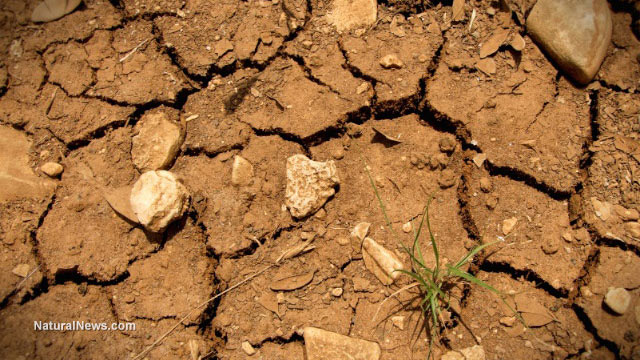Devastating drought is imminent: Scientists surprised to find Colorado River Basin drying up faster than expected
Monday, March 21, 2016 by: J. D. Heyes
Tags: Colorado River Basin, groundwater depletion, drought

(NaturalNews) More than a half-dozen Western states that depend on the Colorado River Basin for the bulk of their water are drawing much more heavily from groundwater supplies than previously thought, according to a new study, which is the latest indication that the historic drought gripping much of the region is threatening their future access to water.
According to The Washington Post, over the past nine years the basin -- covering Wyoming, Utah, California, Colorado, New Mexico, Arizona and Nevada -- has lost some 65 cubic kilometers of fresh water, which is nearly double the volume of the country's largest reservoir, Lake Mead. It was a figure that truly surprised the study's authors, who used data from a NASA weather satellite to examine groundwater supplies.
"We don't know exactly how much groundwater we have left, so we don't know when we're going to run out," said Stephanie Castle, a water resources specialist at the University of California, Irvine, and the study's lead author. "This is a lot of water to lose. We thought that the picture could be pretty bad, but this was shocking."
About two-thirds of water lost over the past near-decade came from underground supplies, instead of surface water, the Post reported, citing the study's findings.
"We were shocked to see how much water was actually depleted underground," Castle told the paper.
Although surface water in the Colorado River Basin is regulated closely by the U.S. Bureau of Reclamation, states regulate groundwater on their own. And some of them, such as California, do not have groundwater management regulations, though others, such as Arizona, have gone as far as transferring surface water from the Colorado River to underground aquifers for later use.
'It can take hundreds of years to refill groundwater basins'
As noted by the Post:
The Bureau of Reclamation allocates water in strict proportions to each of the seven states within the basin, where 40 million people rely on the Colorado River.
Those allocations have gotten smaller as drought has swept the West over the past 14 years. Lake Mead is at its lowest level since it was created, after construction of the Hoover Dam in the 1930s, leaving a "bathtub ring" around the lake. Most years, every drop of water is pumped out of the Colorado River before it empties into the Gulf of California.
Yet, what surprised researchers in particular was how much groundwater had been accounting for the difference. Indeed, in excess of three-quarters of water lost over the past nine years came from underground. And groundwater does not replenish itself as quickly as surface water, which collects from rain and snow. The unexpected heavy use is straining resources that were already limited.
"You get a wet year, you get some precipitation, and those reservoirs can fill right back up," Castle said. "It can take years, or hundreds of years, to refill groundwater basins."
'We really don't know how much water is down there'
"The Colorado River Basin is the water lifeline of the western United States," said senior author Jay Famiglietti, senior water cycle scientist at NASA's Jet Propulsion Laboratory on leave from UC Irvine, where he is an Earth system science professor.
"With Lake Mead at its lowest level ever, we wanted to explore whether the basin, like most other regions around the world, was relying on groundwater to make up for the limited surface-water supply. We found a surprisingly high and long-term reliance on groundwater to bridge the gap between supply and demand," he said.
The study's authors concluded that federal officials allocated 30 percent more water from the Colorado River than was available; the gaps were then made up from groundwater.
Across the Western states, farmers and urban centers that rely on groundwater are already seeing their water tables decline, which indicates that supplies are running low.
"We really don't know how much water is down there. We've already depleted a lot of it. There could be more, but when we have to start to dig deeper to access it, that's a bad sign," Castle said. "If [ground water basins] continue to be depleted, they don't come back up."
Sources:
http://news.uci.edu
http://www.washingtonpost.com
http://science.naturalnews.com
Colorado River Basin at FETCH.news
Get independent news alerts on natural cures, food lab tests, cannabis medicine, science, robotics, drones, privacy and more.
Take Action: Support Natural News by linking to this article from your website
Permalink to this article:
Embed article link: (copy HTML code below):
Reprinting this article:
Non-commercial use OK, cite NaturalNews.com with clickable link.
Follow Natural News on Facebook, Twitter, Google Plus, and Pinterest
- Aerosolized bioweapons? Strange “diploid biomasses” falling out of the sky in Florida captured under the microscope
- Widespread social and economic unrest: Steve Quayle issues urgent financial warning of imminent asset collapse in new interview with Mike Adams
- Transhuman vectors of disease: Young adults continue to produce spike proteins ONE YEAR after receiving COVID vaccine
- Kiss Your Genetic Privacy Good-Bye! 23andMe Gets Green Light to Sell Your Intimate Genetic Details to Anyone They Want
- Analysis: The coming economic collapse, a mass uprising and Trump's three secret weapons to halt the growing revolt
- Fauci is back in the limelight, and he’s busy promoting a future COVID or FLU pandemic
- Prominent doctors call for new holistic therapies to address CANCER SPIKE: Tree barks provide anti-cancer treatment options
- Mike Adams releases country western hit single: Goin’ Back in Time is Comin’ Home
- 8 U.S. states may EXPAND vaccine exemptions in 2025, and parents have many reasons to STOP THE SHOTS
- Israeli lobbyists boast of controlling US national security policy in leaked AIPAC audio
- U.S. lawmakers investigate Meta over alleged China collaboration
- Ancient mummies rewrite human history with “ghost” lineage discovery
- Russia escalates censorship war, targets over 200 VPN apps amid Google resistance
- Surge in KIDNEY FAILURES linked to common medications
- Mel Gibson sparks outcry over 9/11 ‘Biggest Scandal’ remark as unanswered questions resurface
- TAKE IT DOWN Act advances in Congress amid free speech concerns
- DMSO and Natural Dyes: A suppressed cancer treatment resurfaces in independent research
- CLOT SHOT PLANDEMIC UNFOLDING: Fibrous, rubbery clots caused by covid injections have prion-like seeding activity
- Israeli lobbyists boast of controlling US national security policy in leaked AIPAC audio
- Aerosolized bioweapons? Strange “diploid biomasses” falling out of the sky in Florida captured under the microscope
- Analysis: The coming economic collapse, a mass uprising and Trump's three secret weapons to halt the growing revolt
- Fauci is back in the limelight, and he’s busy promoting a future COVID or FLU pandemic
- Widespread social and economic unrest: Steve Quayle issues urgent financial warning of imminent asset collapse in new interview with Mike Adams
- Kiss Your Genetic Privacy Good-Bye! 23andMe Gets Green Light to Sell Your Intimate Genetic Details to Anyone They Want
- Mike Adams releases country western hit single: Goin’ Back in Time is Comin’ Home
- U.S. lawmakers investigate Meta over alleged China collaboration
- Tulsi Gabbard leads charge against the Biden regime’s global censorship of the 'Disinformation Dozen'
- Pfizer's RSV vaccine linked to preterm births as drug giant CONCEALED RISKS from pregnant women in unethical clinical trials
- Dane Wigington exposes climate engineering as ‘All-Out Weather and Biological Warfare’
- Shedding light on the dark side of MMR vaccines: How vaccinated individuals SPREAD MEASLES & put the vulnerable at risk
- TAKE IT DOWN Act advances in Congress amid free speech concerns
- CLOT SHOT PLANDEMIC UNFOLDING: Fibrous, rubbery clots caused by covid injections have prion-like seeding activity
- Chemtrails unveiled: How the CIA and Big Business are manipulating the weather for profit
- Curcumin’s ancient healing power supercharges muscle recovery, and its effects are compounded with anti-inflammatory foods and supplements
- Criminal referral requests filed against Fauci and top COVID officials in seven states
- Defunding DEADLY mRNA jabs: Government funding for mRNA technology being scrutinized and sidelined until proven "safe and effective" for real
- Newly released JFK files reveal Pentagon's role in creating Lyme disease and covid in the same lab
- Analysis: The coming economic collapse, a mass uprising and Trump's three secret weapons to halt the growing revolt
- Mike Adams releases country western hit single: Goin’ Back in Time is Comin’ Home
- Aerosolized bioweapons? Strange “diploid biomasses” falling out of the sky in Florida captured under the microscope
- Kiss Your Genetic Privacy Good-Bye! 23andMe Gets Green Light to Sell Your Intimate Genetic Details to Anyone They Want
- European Court of Justice: Healthcare professionals who promoted or administered COVID-19 vaccines are CRIMINALLY LIABLE for any harm caused
- Federal employees whine over DOGE's new directive requiring them to do a 5-point summary of weekly accomplishments
- Widespread social and economic unrest: Steve Quayle issues urgent financial warning of imminent asset collapse in new interview with Mike Adams
- U.S. approves new Russian ambassador as diplomatic thaw continues
- Government waste exposed: Hegseth supports Musk’s demand for accountability from federal workers
- Now you can HEAR chemistry: Health Ranger translates molecules into music in stunning video demonstration that will blow your mind (and your ears)
- Fauci is back in the limelight, and he’s busy promoting a future COVID or FLU pandemic
- CLOT SHOT PLANDEMIC UNFOLDING: Fibrous, rubbery clots caused by covid injections have prion-like seeding activity
- I Want My Bailout Money – new song released by Mike Adams
- I Want My Bailout Money – new song and music video released by Mike Adams
- Tulsi Gabbard leads charge against the Biden regime’s global censorship of the 'Disinformation Dozen'
- Trump administration poised to overhaul crypto regulations with new SEC leadership
- The Health Ranger releases “Vaccine Zombie” song and music video, using AI-animated zombies for the music video
- Red Cross issues warning to stop blood plasma donations from vaccinated people
- Scientists confirm: GENIUS brain function can be spontaneously unleashed in humans without any apparent cause
- EPA advisor admits the agency is funneling billions to climate groups ahead of Trump’s return to White House
- HYSSOP: What research reveals about the health benefits of this ancient holy herb
- Two containers with completed ballots fall out of truck in Florida
- Newly released JFK files reveal Pentagon's role in creating Lyme disease and covid in the same lab
- Global leaders unite to clamp down on “misinformation” with UN-backed Cascais Declaration
- Mike Adams releases country western hit single: Goin’ Back in Time is Comin’ Home
- BREAKING: 2025 NDAA authorizes mandatory military draft of WOMEN across America… as Pentagon pursues global NUCLEAR war with both Russia and China at the same time
- Michael Yon warns of a ZIONIST TAKEOVER in Trump’s second administration
- The Health Ranger releases “Vaccine Zombie” song and music video, using AI-animated zombies for the music video
- Ozempic and Wegovy weight loss drugs are injectable LIZARD VENOM PEPTIDES that may unleash a devastating wave of organ failure… side effects align with symptoms of SNAKE BITES
- BOMBSHELL: DNA testing kits are a SCAM to develop ethnic-specific bioweapons
- Israeli soldiers accused of even more torture and abuse in the West Bank
- I Want My Bailout Money – new song released by Mike Adams
- These 13 countries just signed an agreement to engineer a global FAMINE by destroying food supply
- NASA admits that climate change occurs because of changes in Earth’s solar orbit, and NOT because of SUVs and fossil fuels
- RFK Jr. clears key hurdle: Sen. Susan Collins backs controversial HHS nominee, signaling a new era for health policy
Science News & Studies
Medicine News and Information
Food News & Studies
Health News & Studies
Herbs News & Information
Pollution News & Studies
Cancer News & Studies
Climate News & Studies
Survival News & Information
Gear News & Information
News covering technology, stocks, hackers, and more



"Big Tech and mainstream media are constantly trying to silence the independent voices that dare to bring you the truth about toxic food ingredients, dangerous medications and the failed, fraudulent science of the profit-driven medical establishment.
Email is one of the best ways to make sure you stay informed, without the censorship of the tech giants (Google, Apple, Facebook, Twitter, YouTube, etc.). Stay informed and you'll even likely learn information that may help save your own life."
–The Health Ranger, Mike Adams












































